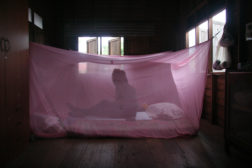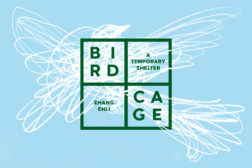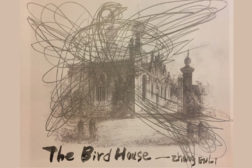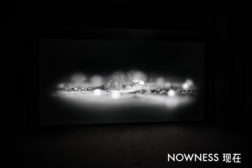
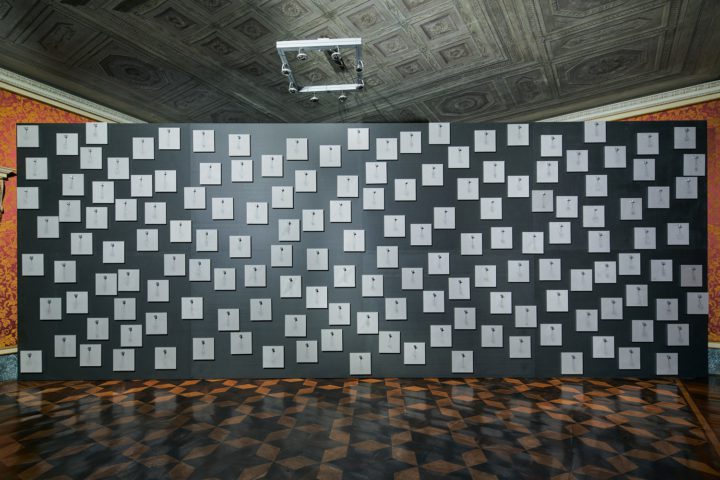
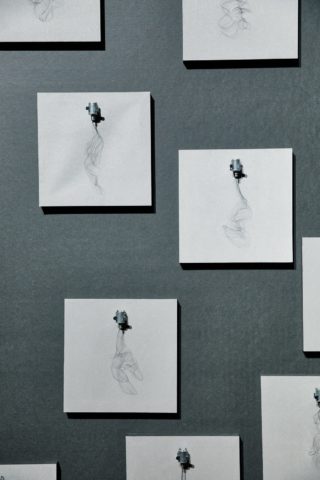

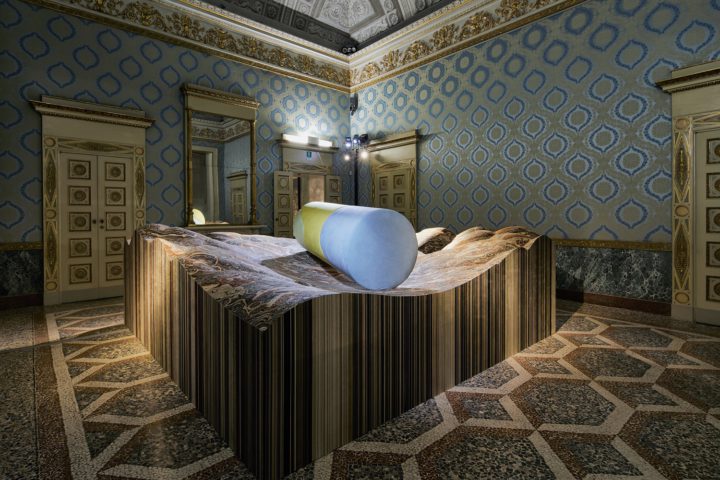

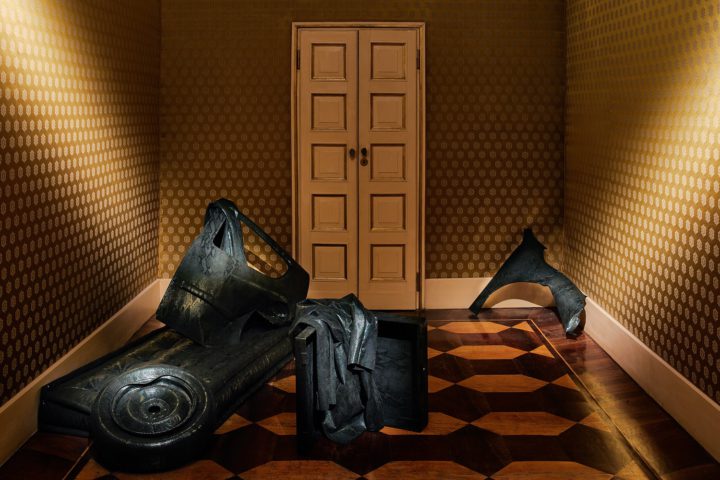
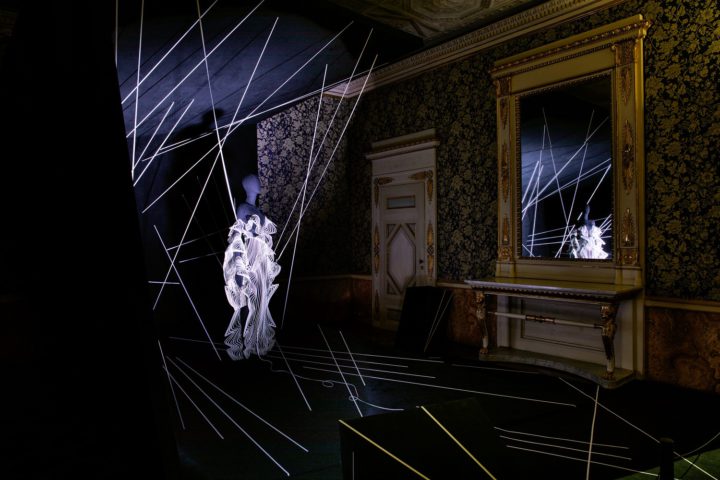
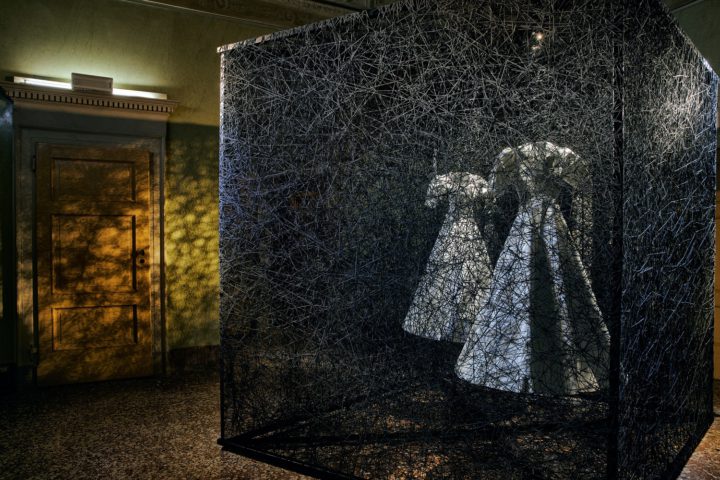
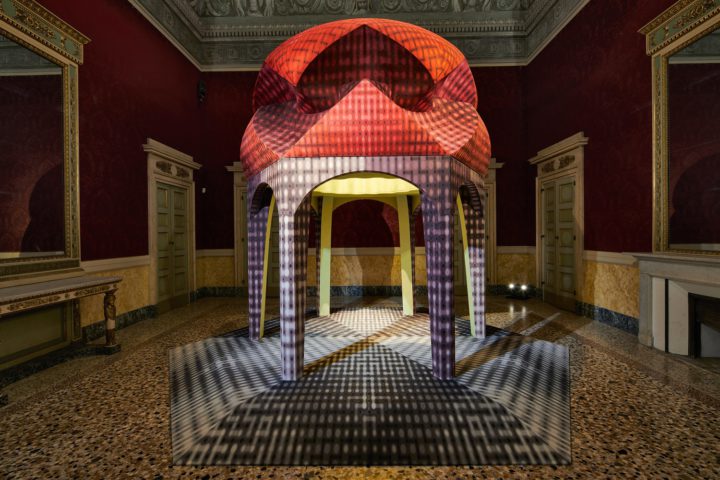
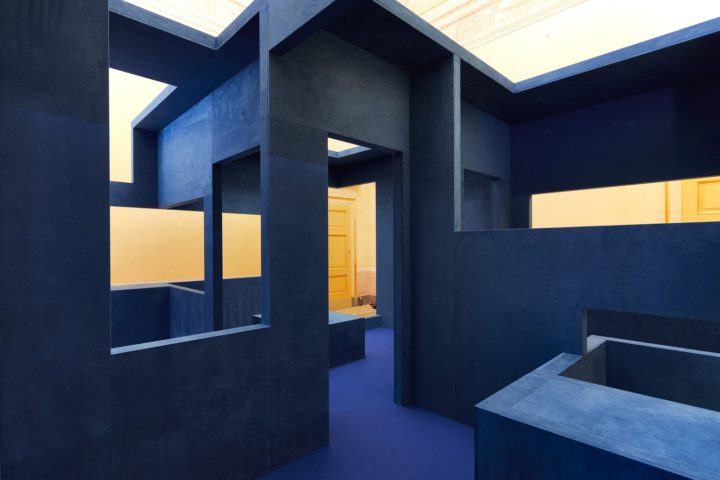
Nine Journeys Through Time
NINE JOURNEYS THROUGH TIME
Alcantara and Art in the Apartment of the Prince
Duration: 2018 April 5 – May 13
Venue: Apartment of the Prince, Royal Palace, Milan
FREE ENTRANCE
Participated artists:
Aaajiao, Andrea Anastasio, Caterina Barbieri, Krijn De Koning, Li Shurui, Chiharu Shiota, Esther Stocker and Iris Van Herpen, Zeitguised, Zimoun
Curators: Davide Quadrio, Massimo Torrigiani
About the Exhibition
Curated by Davide Quadrio and Massimo Torrigiani, the exhibition is the third episode in a cycle of shows, which since 2016 explore the surprising qualities of Alcantara® as a material for artistic creation, transforming the spaces of the Apartment of the Prince into gateways onto the ‘elsewhere’ realms of art.
“An object, a face, a light and even a material: anything may be a source of inspiration for an artist” states the Councilor for Culture Filippo Del Corno.
“For the third time, the visitor will be amazed to see how and just how differently the stylistic approach and the imagination of each artist manage to channel their creativity and talent, despite all setting off from the same ‘starting blocks’. The Alcantara exhibition portrays this very challenge, and again this year, it will welcome the public of the Milanese Art Week in the chambers of the Apartment of the Prince of Palazzo Reale.”
With this new project, the Company that produces and markets Alcantara® throughout the world continues its original research and development activities, opening up once again to both established and emerging artists from various fields of contemporary creativity, inviting them to get to grips with original, complex and unique works of art.
Time is that fragmented line that ties us to the past and which we try to trace into the future. A minute, an hour, ten years, what is yet to come.
It’s the rhythm of nature and of the universe, of physics, which wipes away the illusions of linearity, acting back and forth, altering the links between cause and effect, the before and after. It opens up giddying, inconceivable glimpses, wearing down common sense and certainties. Or it may be that of scientists. What guides us through the world day after day; what evolution has led us to conceive of as the only form of it useful to us, on a human scale, tied down to the cycles of birth, growth, demise and rebirth.
As Leopardi said, “The infinite is a part of our imagination, of our littleness and at the same time of our pride […] the infinite is an idea, a dream, not a reality: at least, no proof do we have of its existence, not even by analogy.”
And so what should we say?
Given the past of these rooms, we cannot but wonder about time. That has been the case in all three of the shows we have staged here. The past is an enigma. It makes us wonder about the coexistence of different times. Mine, yours, that of those who came before us and of those who will come after. Nostalgia, the eternal present, the longing to be able to guide the future.
Instead, we so often have the sensation not of thinking but of being thought; not of acting but of being acted. The expansion of consciousness: yet another time.
Thinking of the artists who could have imagined this journey along with us, the array of elements we came up with what might together constitute a symphony on time are synchrony, multiplicity, music, rhythm, memory, slowness and stasis.
Thus, one by one, one after another, the artists you will find, and who will find you, in the following
rooms appeared to us. A laboratory of weird science, a sound box. Nine Journeys Through Time.
“We do not exist in the majority of these times; in some you exist, and not I; in others I, and not you; in others, both of us. In the present one, which a favorable fate has granted me, you have arrived at my house; in another, while crossing the garden, you found me dead; in still another, I utter these same words, but I am a mistake, a ghost.” From The Garden of Forking Paths (1941) by Jorge Luis Borges
–Davide Quadrio and Massimo Torrigiani
In Nine Journeys Through Time, offering an exceptional combination of talents, 10 artistic approaches are brought together through 9 projects (Esther Stocker and Iris van Herpen have come up with a joint project) in a range of media. From the transfiguration of painting to fashion, from digital design to music, they all draw inspiration from the specifics of a unique material: Alcantara®, analyzing all its various declinations and potential, exploring its invention and production processes, working with technicians and experts, be it along independent paths or through innovative collaboration projects.
Each of them – including the unprecedented coupling of Stocker and van Herpen – has come up with a site-specific work, dialoguing with the Apartment of the Prince, itself a setting charged with great creative energy: a launch pad for journeys ranging from anomalous science laboratories, anacondas, mutations, sinusoids, oracular apparitions, quirky metronomes, twisting from the natural to the artificial and back again. A succession of fantastical scenarios ranging from ephemeral architecture to interactive sound devices.
Just like in the previous two shows, Fantasy Access Code and The King and I, here too one of the main threads – ‘time’ – is the result of a conversation among the artists, who had the chance to meet together both at Palazzo Reale and in the Alcantara production plant at the start of the project and, on some occasions, during its staging.
But ‘time’ is also the result of the dialogue between artists and the material, artists and places, artists and curators. In this case, the Apartment of the Prince led to a reflection on the various dimensions of time: on ‘our’ time, the everyday, practical and fleeting, opposed (or complementary) to ‘scientific time’, dilated and imperceptible.
Like in the other two exhibitions, the thought at the heart of the exhibition itinerary is our own.
Nine Journeys Through Time is designed to provide an experiential journey, one to be undertaken by spirits willing to let themselves be enveloped in a sense of wonder. Each setting turns out to be a surprise that projects us into a sequence of diverse and enthralling space-time dimensions. A journey, at times abstract yet never out of reach, which buffers us between changing worlds and startling aesthetic experiences.
The microscopic reality placed before us by Aaajiao, the wall of percussive micro-variations offered by Zimoun, the zoomorphic geometries of Esther Stocker and Iris van Herpen. The world altered by the mysterious chimera of Andrea Anastasio and the thick spider webs of Chiharu Shiota. Zeitguised’s digital anamorphosis, the electronic universe of Caterina Barbieri and her interactive synthesizer. The time in the fourth dimension, one beyond our experience and comprehension, as evoked by Li Shurui. The spatial and temporal references of the architecture enveloping the exhibition and which vanish in the room of Krijn de Koning.
“This cycle of exhibitions is the most complex and intriguing project that we have worked on over recent years. Bringing together Alcantara, the company and the material, 25 artists, more than 20 original works, and the aim of arousing public interest, all hosted at Palazzo Reale, has proved a challenge that we think has opened up new horizons in the world of commissioning and the relationship between the public and private sectors. Nine Journeys Through Time follows on from the other two exhibitions like the unfolding of a thought or a dream, and this is perhaps the essence of what we have managed to do throughout the cycle: a process that has driven ever further forward the dialogue between artists, Alcantara® and the spaces of the Apartment of the Prince. We concede ourselves the presumptuousness to think that those who visit it will move on from surprise to surprise, as happened to us during the preparation process, along with the artists, the managers of Alcantara, the technicians and our various collaborators. It’s an exhibition of ‘anticipation’, as once used to be said about science fiction.” This is how the curators of the exhibition, Davide Quadrio and Massimo Torrigiani, commented on it.
THE EXHIBITION ITINERARY
The first room of the Apartment of the Prince hosts the work that opens the exhibition itinerary: Desire by Aaajiao. On entering a blanched environment, the walls coated in white Alcantara®, the visitors are projected into a clinical and microscopic spatial dimension, coming face to face with the fundamental unity of Alcantara®: its very DNA. The time of its coming into being. A large transparent organic-shaped capsule withholds a body with blurred edges to it, the initial phase of the production process of the material: this is the ‘flake’, the primary form of Alcantara® which precedes that of needle-punching, the process which through a system of moving needles provides the material with shape and compactness.
In the following room, we come across the work by Zimoun: 156 prepared dc-motors, wires, mdf boxes 30x30x3cm. A wall cuts through the space diagonally and literally ‘sings out’ the sound properties of Alcantara®, beating out its rhythm. Here the material – used in its raw form, without colourings or finishings – is presented like a skin, stretched over a series of drums beaten mechanically, thanks to a system of electric DC motors. The reverberating of the unusual covering, multiplied dozens of times along the space, offers a chain of acoustic emissions: potentially infinite, repetitive, but never the same as itself. The room and the material thus form an unprecedented and gigantic musical instrument with hypnotic sonorities.
The third environment is the stage of the collaboration project between the designer Iris van Herpen and the artist Esther Stocker: Extended Indefinitely. A sculpture-garment, created through a painstaking crafts process applied to Alcantara®, seems to place the visitor before the simulacrum of an unknown civilisation, one from the future or some long forgotten era. The garment, a phantasmagorical presence, comes to life, reaching out into all directions in a dark setting, punctuated by thin thread of white Alcantara® and a choreography of light beams: white blades cutting through undefined time and space.
The two following rooms are those entrusted to Andrea Anastasio and his Eden. Inspired by a giant anaconda, a metaphor for consumption society, gobbling up everything in its path, the work is presented as a synthesis of elements of industrial production, brought together with decorative citations from the Apartment of the Prince and interspersed with splendid floral elements. The visitor is led along a path through a landscape of urban furnishings, ennobled and transformed into living matter by a luxurious yet unsettling ‘skin’ of Alcantara®: a python that has shed its skin, its scales all shiny. Objects common to every living creature today, both human and not. The omnivorous quality of luxury.
The dream of Chiharu Shiota, Reflection of Space and Time, is the next stop. Conceived as a universal place that preserves the memories of humanity, a thick monochromatic spider web – the distinctive sign of the production of the artist, which here foresees the use of 110 kilometres of Alcantara® thread applied during the installation stage – crosses and envelops an internal structure from which two iconic white costumes in Alcantara® stand out. Their image is reflected and multiplied in the mirrors positioned in the centre of the structure and along the walls of the room, altering the physical and temporal perception of the surrounding space, in a continuous toing and froing of views and illusions, of awakeness and dreaming.
The seventh room is the material projection of a computing calculation of procedural geometry, entitled Beyond the Nuclear Garden by the Berlin group Zeitguised. The work is the upshot of an algorithm developed especially for the occasion: from the floor of the room by which it is generated, it creates a distorted island of colours and shapes in Alcantara®. Visitors are met with a chromatic ‘geyser’ on which an organically shaped cylinder rests, the echo of the following room, the setting of the work by Caterina Barbieri. The result of an unprecedented and spontaneous collaboration that emerged during the planning stage of the exhibition.
The setting for the work by Zeitguised extends into the work of the same title by the musician Caterina Barbieri, who shares a love of digital synthesis with the German studio. A love which is also reflected in her meticulous research into the synthetic nature of sound, and in this context, of Alcantara®. Barbieri processed a series of environmental recordings carried out in the Alcantara production plant in Nera Montoro (province of Terni) to create a soundtrack that visitors may activate through a large interactive synthesizer. This all makes us call into question the relationship between the human and the mechanical, the natural and the artificial, listening and sound. Rhythm is nothing if not the idea reproduction of the natural movement of life.
Moving on, we find ourselves in an environment with sacred connotations: a large tholos with a complex curved structure occupies the volume of the room entrusted to Li Shurui. Coated in Alcantara® printed with the optical motifs that characterise the pictorial production of the artist, the Temple of Reverence for Knowledge Beyond Human Comprehension was designed in order for us to humbly entreat the fourth dimension and all those realms of existence beyond our knowledge and experience. So to assist us, by any possible means, in accepting our three-dimensional, linear and time-restrained clumsiness, and in expanding our consciousness.
The exhibition comes to a close with the Work for Alcantara, Blue Chair by Krijn de Koning, with an operation of spatial estrangement which leads the visitors into a chamber entirely coated in blue Alcantara®, of which the edges of the architectural spaces – doors, windows, passageways and geometric chambers – are superimposed onto the real space, thus creating a fictitious perception of time and space. Inside this ‘room-within-a-room’ looms a chameleonic armchair, the protagonist of the installation, created to reflect the architectural structure featured in the work.
Watch the video above for the making of the exhibition.
BIOGRAPHIES OF THE ARTISTS
Aaajiao
Media artist, blogger, activist and programmer, Aaajiao is the virtual persona of the artist Xu Wenkai, based between Berlin and Shanghai, where he was born in 1984. His transdisciplinary works explore the new technologies and phenomena linked to Internet, concentrating on the elaboration of IT data, the blogosphere and the attempts at censorship and online surveillance put in place by the Chinese Great Firewall. Aaajiao’s work has been displayed in international institutions such as the Institute of Contemporary Art Boston (2018); Haus der Elektronischen Künste, Basel (2017); Centre for Chinese Contemporary Art (Manchester, 2016); Spencer Museum of Art, Kansas (2016); the Jewish Museum, New York (2016); OCAT Contemporary Art Terminal, Xi’an (China, 2016); Yuz Museum, Shanghai (2016); K11 Art Foundation Pop-up Space (Hong Kong) and chi K11 (Shanghai, 2016); ZKM – Centre for Art and Media, Karlsruhe (2015); the National Art Museum of China, Beijing (2014); and Transmediale, Berlin (2010). In 2014, the artist was awarded the jury prize at the Art Sanya Awards, and was nominated for the OCAT-Pierre Huber Art Prize.
Andrea Anastasio
Born in 1961 in Rome, he lives between Naples and Mumbai. After training in Oriental studies and philosophy, he embarked on numerous collaboration projects as a designer, a field in which he still works, for brands such as Artemide, Danese, Foscarini and Memphis, before moving to India in 1991.
Alongside his professional activity, he devotes his time to his own artistic production; his works put forward a reappraisal of industrial design as a philosophy of living. Since 1990, his work has been displayed in numerous museums, galleries and events focusing on design such as, recently, that at the Fondazione Achille Castiglioni, Milan, and the Italian Embassy in Stockholm (2018); Kogei Prefectural Museum of Art and Design, Toyama, Japan, and the Museo Italiano delle Ceramiche, Faenza (2017). Among his numerous awards, we might note in 2017 the USA Interior Design Award for the best table lamp, and in the same year, the ‘Migliore prodotto Euroluce’ Prize in the lighting technology section of the Salone del Mobile in Milan.
Caterina Barbieri
An Italian composer and musician, she was born in Bologna in 1990 and now lives in Berlin. As well as holding a bachelor’s degree in ethnomusicology on Hindustani minimalism, she received a diploma in classical guitar and in electro-acoustic music from the Conservatory of Bologna. Her work explores machine intelligence and object-oriented perception in sound, through the psycho-physical effects of repetition and pattern-based operations in music, by investigating the potential of synthesizers to draw minimal, audio-spatial geometries. Her work has been presented at festivals and institutions such as Ableton Loop, Atonal, CTM, HKW – Haus der Kulturen der Welt, The Long Now and MaerzMusik (Berlin); Moogfest (Durham, UK); Barbican Centre (London); Mutek (Montreal); and the Venice Biennale. Her latest solo album, Patterns of Consciousness (Important Records, 2017) ranked among the best of the year in classifications of international reach, such as those of Boomkat, Fact Mag and The Wire.
Krijn de Koning
Born in 1963 in the Netherlands, he trained in the early ‘90s at the Rietveld Academie and De Ateliers in Amsterdam, and at the Institut des Hautes Études en Art Plastiques in Paris. His work explores the relationship between man and architectural space, through site-specific interventions with sculptural qualities. Winner of the prestigious Sikkens Award in Rotterdam (2007), in 2017 he produced and displayed his work at the Louvain-la-Neuve Biennale in Belgium; Le Shed, Centre d’art contemporain de Normandie; and at the Cityscapes Gallery and ArtZuid in Amsterdam. Some of his works have been purchased by the Stedelijk Museum in Amsterdam; the Museum Boijmans van Beuningen in Rotterdam; and by the French FRAC (Bretagne and Bourgogne) and FNAC among others. From his most recent activities, we might note in 2018 the creation of a work for the submarine base of Saint-Nazaire in France, and a collaboration project with the Israeli choreographer Keren Levi.
Li Shurui
Born in 1981 in Chongqing (China), where she graduated from the Sichuan Fine Art Institute, she lives and works in Beijing. Li Shurui uses painting as a medium to explore the ways in which light and colour may reflect individual needs and desires in various times and cultures. Winner of the New York Fellowship Program of the Asian Cultural Council (ACC) in 2016, she has displayed her work in group shows at prestigious international institutions such as the Chinese Centre for Contemporary Art, Manchester (2018); New Galerie, Paris (2017); Georgian National Museum – Dimitri Shevardnadze National Gallery, Tbilisi (2017); National Museum of Women in the Arts, Washington D.C. (2016); Minsheng Art Museum, Shanghai (2016 and 2015); PAC – Padiglione d’Arte Contemporanea, Milan (2015); Asian Art Museum, San Francisco (2015); and the OCAT Contemporary Art Terminal, Xi’An (China, 2014).
Chiharu Shiota
Born in Osaka in 1972, she lives and works in Berlin. Confronting fundamental human concerns such as life, death and relationships, Shiota explores the sense of human existence either through largescale installations – within which common objects and memorabilia with a symbolic value find their place – or through her drawings, sculptures, photography and videos. In 2015, Shiota represented Japan at the 56th Venice Biennale and over recent years she has presented her works in prestigious international museum institutions such as MoMA PS1, New York; La Maison Rouge, Paris; The Museum of Art, Kōchi; Freer and Sackler Galleries of Art, Washington D.C.; Power Station of Art, Shanghai; and K21 Kunstsammlung Nordrhein-Westfalen, Düsseldorf. Furthermore, her work has been presented at the Sydney Biennale; Gwangju Biennale (South Korea); the Setouchi International Art Festival; and the Yokohama Triennale (Japan).
Esther Stocker
Born in Silandro (Italy) in 1974, she graduated from the Academy of Fine Arts of Brera in Milan and the Akademie der Bildenden Künste in Vienna, specialising at the Art Center College of Design in Pasadena, California. Her works – paintings and installations that often establish dialogue between one another – are characterised by the use of neutral shades such as black, grey and white, and by their geometric and essential nature. As well as in group shows in Europe and the United States, her work has been featured in solo exhibitions at institutions and galleries such as: Galerie Frey, Salzburg (2017); d.a.c. dolceacqua arta contemporanea, Imperia (2017); Setouchi Triennale, Japan (2016); La BF15, Lyon (2016); Dom umenia/Kunsthalle Bratislava (2016); Kunstverein Ludwigsburg (2015); and the Galerie Alberta Pane, Paris (2015).
Iris van Herpen
Born in the Netherlands in 1984, ever since her first fashion show in 2007 she has risen to international fame as one of the most innovative designers in the fashion world thanks to her unprecedented experimental creations. In her work, she uses traditional materials together with technologies and production techniques uncommon in the sartorial world, such as her pioneering use of 3D printing to breathe life into unique and visionary creations: an approach that she herself defines as ‘New Couture’. As well as numerous collaborations with artists, architects and scientific research centres (CERN and MIT), and her constant presence in the Paris Haute Couture calendar since 2011, her work has been presented in museum institutions such as the Victoria & Albert Museum (London), the Cooper Hewitt Museum (New York) and the Palais de Tokyo (Paris), as well as in a major touring retrospective in the United States. Some of her garments are to be found in the permanent collection of the MoMA in New York, and in the prestigious retrospective at the Metropolitan Museum of Art in New York Manus x Machina: Fashion in an Age of Technology.
Zeitguised
Founded in Berlin in 2001 by Jamie Raap and Henrik Mauler, Zeitguised is a studio of art and digital design, specialising in the production of visual projects (both commercial and independent) of an algorithmic nature. Right from the beginning, thanks to an innovative and experimental approach to new technologies, the group’s work has been featured in a number of art fairs and festivals dedicated to new media, such as Onedotzero, Dotmov, Nemo, ITFS and Resfest, and has received numerous awards: nominated for two consecutive Media Art Awards at the ZKM in Karlsruhe (2001 and 2002), the group was given the prize for the best musical video at the International Cinema Festival of Oberhausen (2005), and in the same year, the Best Design Award at the Resfest. This was followed, in 2009, by the prize for the best experimental work at the Ottawa International Animation Festival and, in 2010,
Zeitguised was shortlisted for the experimental section of the Vimeo Festival + Awards in New York; the group also won two Laus awards (2014 and 2015), and was given two mentions of honour at Ars Electronica (Linz); in 2016, the group was awarded the Best Experimental and Best VFX prizes at the Berlin Fashion Film Festival, and bronze from the Ciclope Festival in Berlin. Zeitguised’s works have been displayed in museums and art events throughout the world.
Zimoun
Born in Switzerland in 1977, Zimoun uses simple and functional components to build architecturally minded platforms of sound. Exploring mechanical rhythm and flow in prepared systems, his installations are characterised by the presence of commonplace industrial objects. In an obsessive display of simple and functional materials, these works articulate a tension between the orderly patterns of Modernism and the chaotic forces of life. Carrying an emotional depth, the acoustic hum of natural phenomena is reflected spontaneously in the artist’s minimalist architecture. Zimoun’s work has been displayed throughout the world, most recently at the MAC – Museum of Contemporary Art, Santiago del Chile; Nam June Paik Art Museum, Seoul; Kuandu Museum of Fine Arts, Taipei; Ringling Museum of Art, Florida; Dr Bhau Daji Lad Mumbai City Museum, Mumbai; National Art Museum, Beijing; LAC Art Museum, Lugano; Seoul Museum of Art; Museo MIS, São Paulo; Kunsthalle Bern; Le Centquatre, Paris; Museum of Contemporary Art, Busan (South Korea); and at the MBAL – Museum of Fine Arts, Le Locle (Switzerland).
About Curators
After having founded and directed the BizArt Center between 1998 and 2010, the first non-profit artistic/creative laboratory in Shanghai, where he lived from 1994 to 2017, in 2007 Davide Quadrio created Arthub Asia: a platform dedicated to the production and promotion of contemporary art in Asia and throughout the world. In the arena of these experiences, he staged numerous exhibitions, teaching projects and cultural exchange programmes, fostering relationships between institutions around the world. This work led to the inclusion of BizArt as a special project in Art and China after 1989: Theater of the World at the Guggenheim in New York, 2017. From 2005 to 2008, he served as artistic director of the creative space Bund18 in Shanghai, where he curated the Chinese edition of the exhibition on Vivienne Westwood by the Victoria & Albert Museum, as well as the touring show on Droog Design (Shanghai, Shenzhen, Beijing), and the solo exhibition by Olivo Barbieri as part of the Shanghai Biennale, an institution for which in 2012 he coordinated the project ‘City Pavilions’. His most recent initiatives include the retrospective Journeys Without Arrivals by Qiu Zhijie (Vanabbe Museum; Centre d’Art Contemporaine de Geneve; Kunstalle Lund); the double solo show by Zhang Enli and Christopher Doyle at the Aurora Museum in Shanghai; the solo show by Paola Pivi Tulkus 1898-2018 (Castello di Rivoli; Witte de With; Frac Dijon); newly commissioned work by Yang Fudong for the Toronto Film Festival 2013; and the solo show by Jompet at the Fondazione Gervasuti di Venezia during the Venice Biennale 2011. As a curator of the Aurora Museum of Shanghai from 2013 to 2016, from 2015 to 2016 he curated the pop-up edition of the magazine Kaleidoscope Asia. Since September 2017 he has resided in Milan.
Massimo Torrigiani is the artistic director of the project for the upcoming centre for contemporary arts of the Municipality of Bari, and is a member of the artistic committee of the Triennale Teatro dell’Arte. From 2013 to 2016 he presided over the scientific committee of the PAC, an exhibition space for contemporary art belonging to the Municipality of Milan, and from 2014 to 2017 he was the artistic director of Art In The City Shanghai: a festival dedicated to the new creative scene in China. He is currently the artistic director of Capo d’Arte, a non-profit organisation dedicated to contemporary art, which every summer also holds a series of exhibitions in Gagliano del Capo (Lecce), in collaboration with Villa Medici: the French Academy in Rome. He has curated solo shows including those of Yang Fudong, the Soundwalk Collective and Shilpa Gupta. Since 2009 he has co-directed the activities of Fantom, a curatorial and publishing project focusing on photography and sound. From 2010 to 2012, he directed the Contemporary Art Fair in Shanghai. From 2004 to 2009 he headed the monthly culture journal Rodeo. Over the years, he has written about art, music and culture for international magazines; he has contributed to research projects on cultural policy with institutions like the Council of Europe and the De Montfort University of Leicester; he has worked as a consultant for fashion and design companies; and he has also organised concerts and DJ sets in clubs, theatres and non-conventional spaces. He lives in Milan, where Boiler Corporation is based: the creative workshop that he co-founded in 2001 in order to publish the international art magazine Boiler.
Since 2010, Quadrio and Torrigiani have collaborated on a series of exhibitions and projects. Among these, with Alcantara, the group shows Codice di avviamento fantastico / Fantasy Access Code and Ho visto un re / The King and I (both staged in Milano and Shanghai); the Contemporary Art Fair of Shanghai; the retrospective of Yang Fudong for Capo d’Arte 2014; the festival Art In The City Shanghai; and the activities of the Scientific Committee of the PAC in Milan.
The curatorial coordination of the exhibition, of the production of the works and their display is by Selva Barni with Ilaria Speri, of Fantom.
THE APARTMENT OF THE PRINCE
The Apartment of the Prince, comprised of ten rooms in the south-west wing of the Royal Palace, represents a precious example of a royal home from the early 19th century, still virtually intact. Foreseen in the Napoleonic reorganisation of the building in 1805, it was destined for use as the Appartamento di Riserva per Principi (Apartment Reserved for the Princes) in 1830, destined for any princes or archdukes born from Ranieri’s marriage to Elizabeth of Savoy-Carignano. The restauration works, which foresaw the sophisticated redecoration of the rooms – largely in Restauration style, under the guidance of the architect Giacomo Tazzini – came to an end in 1838, shortly after the arrival of the Emperor Ferdinando I, arriving in Milan to be crowned head of the Lombardo-Venetian Kingdom.
THE ROYAL PALACE
The Apartment may be reached from the Atrium of the Four Columns and what is now the First Chamber of the Tapestries of Palazzo Reale. Housing the city government ever since the late Middle Ages, the Palazzo had been strengthened as a political centre under the dynasties of the Torriani, Visconti and Sforza families. Home to sumptuous courtly life, in the 17th century it passed under the control of the Austrian Empire. After undergoing neo-classical restauration works headed by Giuseppe Piermarini, it was enriched by the monumental stairway at the entrance, by the new façade onto Piazza Duomo and the modern-day Piazzetta Reale. Previously home to kings and queens, in 1919 it was given over to the State and partially opened to the public, having been embellished by the work of great decorators, sculptors, painters and carpenters. Hit by the bombings of 1943, Palazzo Reale lost most of its treasures. For more than 20 years, reconstruction and restoration works were carried out by the Municipality of Milan and the Superintendency for Archaeological Heritage, prior to its final reopening as an exhibition venue.
